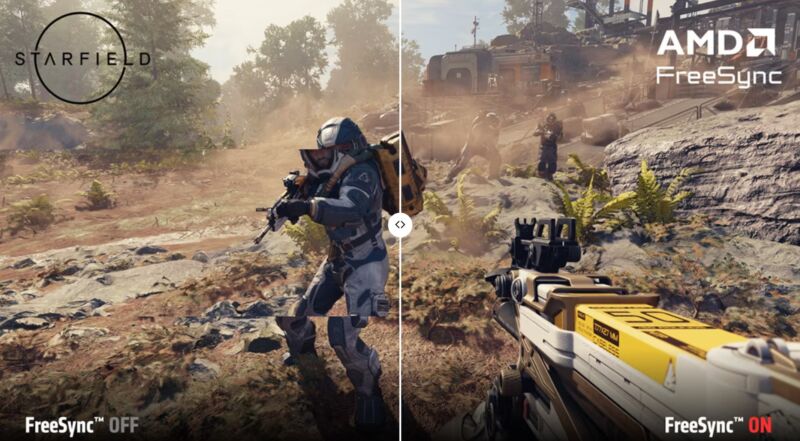AMD stops certifying monitors, TVs under 144 Hz for FreeSync

Enlarge / AMD’s depiction of a game playing without FreeSync (left) and with FreeSync (right).
AMD announced this week that it has ceased FreeSync certification for monitors or TVs whose maximum refresh rates are under 144 Hz. Previously, FreeSync monitors and TVs could have refresh rates as low as 60 Hz, allowing for screens with lower price tags and ones not targeted at serious gaming to carry the variable refresh-rate technology.
AMD also boosted the refresh-rate requirements for its higher AdaptiveSync tiers, FreeSync Premium and FreeSync Premium Pro, from 120 Hz to 200 Hz.
Here are the new minimum refresh-rate requirements for FreeSync, which haven’t changed for laptops.
| Laptops | Monitors and TVs | |
|---|---|---|
| FreeSync | Max refresh rate: 40-60 Hz | < 3440 Horizontal resolution: Max refresh rate: ≥ 144 Hz |
| FreeSync Premium | Max refresh rate: ≥ 120 Hz | < 3440 Horizontal resolution: Max refresh rate: ≥ 200 Hz≥ 3440 Horizontal resolution: Max refresh rate: ≥ 120 Hz |
| FreeSync Premium Pro | FreeSync Premium requirements, plus FreeSync support with HDR | FreeSync Premium requirements, plus FreeSync support with HDR |
AMD will continue supporting already-certified FreeSync displays even if they don’t meet the above requirements.
Interestingly, AMD’s minimum refresh-rate requirements for TVs go beyond 120 Hz, which many premium TVs currently max out at, due to the current-generation Xbox and PlayStation supporting max refresh rates of 120 frames per second (FPS).
Announcing the changes this week in a blog post, Oguzhan Andic, AMD FreeSync and Radeon product marketing manager, claimed that the changes were necessary, noting that 60 Hz is no longer “considered great for gaming.” Andic wrote that the majority of gaming monitors are 144 Hz or higher, compared to in 2015, when FreeSync debuted, and even 120 Hz was “a rarity.”
Since 2015, refresh rates have climbed ever higher, with the latest sports targeting competitive players hitting 500 Hz, with display stakeholders showing no signs of ending the push for more speed. Meanwhile, FreeSync cemented itself as the more accessible flavor of Adaptive Sync than Nvidia’s G-Sync, which for a long time required specific hardware to run, elevating the costs of supporting products.
AMD’s announcement didn’t address requirements for refresh-rate ranges. Hopefully, OEMs will continue making FreeSync displays, especially monitors, that can still fight screen tears when framerates drop to the double digits.
The changes should also elevate the future price of entry for a monitor or TV with FreeSync TV. Sometimes the inclusion of FreeSync served as a differentiator for people seeking an affordable display and who occasionally do some light gaming or enjoy other media with fast-paced video playback. FreeSync committing itself to 144 Hz and faster screens could help the certification be aligned more with serious gaming.
Meanwhile, there is still hope for future, slower screens to get certification for variable refresh rates. In 2022, the Video Electronics Standards Association (VESA) released its MediaSync Display for video playback and AdaptiveSync for gaming, certifications that have minimum refresh-rate requirements of 60 Hz. VESA developed the lengthy detailed certifications with its dozens of members, including AMD (a display could be MediaSync/AdaptiveSync and/or FreeSync and/or G-Sync certified). In addition to trying to appeal to core gamers, it’s possible that AMD also sees the VESA certifications as more appropriate for slower displays.
AMD stops certifying monitors, TVs under 144 Hz for FreeSync Read More »
